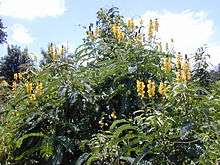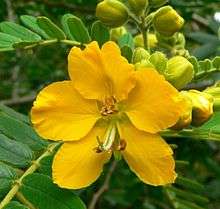Senna (plant)
| Senna | |
|---|---|
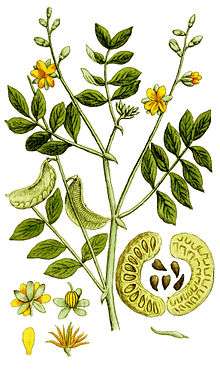 | |
| Senna alexandrina | |
| Scientific classification | |
| Kingdom: | Plantae |
| (unranked): | Angiosperms |
| (unranked): | Eudicots |
| (unranked): | Rosids |
| Order: | Fabales |
| Family: | Fabaceae |
| Subfamily: | Caesalpinioideae |
| Tribe: | Cassieae |
| Subtribe: | Cassiinae |
| Genus: | Senna Mill. |
| Type species | |
| Senna alexandrina Mill. | |
| Species | |
|
Around 260-350, see text | |
| Synonyms | |
|
Cathartocarpus (partim) | |
Senna (from Arabic sanā), the sennas, is a large genus of flowering plants in the legume family Fabaceae, and the subfamily Caesalpinioideae. This diverse genus is native throughout the tropics, with a small number of species in temperate regions. The number of species is estimated to be from about 260[1] to 350.[2] The type species for the genus is Senna alexandrina. About 50 species of Senna are known in cultivation.[3]
Description
Senna includes herbs, shrubs, and trees. The leaves are pinnate with opposite paired leaflets. The inflorescences are racemes at the ends of branches or emerging from the leaf axils. The flower has five sepals and five usually yellow petals. There are ten straight stamens. The stamens may be different sizes, and some are staminodes. The fruit is a legume pod containing several seeds.[4]
Systematics
Chamaecrista, Cassia, and Senna form a monophyletic group which some authors have called Cassia sensu lato.[5] In 1982, the group was named Cassiinae and classified as a subtribe of the tribe Cassieae.[6] The tribe Cassieae contains 21 genera and is now known to be polyphyletic,[5] but the classification is still accepted because a revision of Fabaceae has yet to be published.[5]
The genus Senna has had a complex taxonomic history.[7] What is now known as Senna was included by Linnaeus in his concept of Cassia in Species Plantarum in 1753.[8] Philip Miller segregated Senna from Cassia in 1754 in the fourth edition of The Gardeners Dictionary.[9] Until 1982, many authors, following Linnaeus, did not recognize Senna and Chamaecrista, but included them in a broadly circumscribed Cassia sensu lato. Phylogenetic analyses of DNA have shown that Chamaecrista, Cassia, and Senna are all monophyletic, but the relationships between these three genera have not been resolved.[1] They are therefore shown in phylogenetic trees as a tritomy.
Ecology
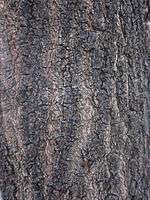
The caterpillars of many Lepidoptera species feed on Senna plants. The black witch (Ascalapha odorata), two-barred flasher (Astraptes fulgerator), common emigrant (Catopsilia pomona), and mottled emigrant (C. pyranthe) have all been recorded on candle bush (S. alata), for example.
Senna species are pollinated by a variety of bees, especially large female bees in genera such as Xylocopa.[1] Some species also have extrafloral nectaries on the leaves or flower stalks, which attract ants, but do not benefit pollinators. The ants probably deter herbivores.[1]
Uses
Some Senna species are used as ornamental plants in landscaping. The species is adapted to many climate types.
Cassia gum, an extract of the seeds of Chinese senna (S. obtusifolia), is used as a thickening agent. The leaves and flowers of Siamese cassia (S. siamea) are used in some Southeast Asian cuisines, such as Thai and Lao cuisines. They are known as khi-lek in Thai, and are used in curries.[10]
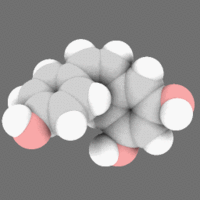
Selected species
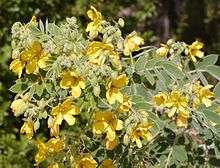
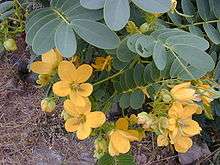
- Senna acclinis (F.Muell.) Randell[11]
- Senna aciphylla (Benth.) Randell
- Senna aculeata (Benth.) H.S.Irwin & Barneby
- Senna alata (L.) Roxb. – candlebush, Christmas candle, empress candleplant, candlestick tree, ringworm bush, seven-golden-candles
- Senna alexandrina Mill. – Alexandrian senna, Indian senna, Tinnevelly senna, true senna
- Senna angulata (Vogel) H.S.Irwin & Barneby
- Senna appendiculata (Vogel) Wiersema (syn. S. australis)
- Senna armata (S.Watson) H.S.Irwin & Barneby
- Senna artemisioides (Gaudich. ex DC.) Randell – grey cassia, leafless cassia, woody cassia, puntybush, silverbush
- Senna auriculata (L.) Roxb. – avaram, Matara-tea, tanner's cassia
- Senna aversiflora (Herbert) H.S.Irwin & Barneby
- Senna bacillaris – West Indian showertree
- Senna barclayana – pepper-leaf senna, smooth senna, yellow peabush
- Senna bicapsularis – rambling senna, Christmas bush, money bush, yellow candlewood
- Senna birostris (Vogel) H.S.Irwin & Barneby
- Senna candolleana (Vogel) H.S.Irwin & Barneby
- Senna cardiosperma (F.Muell.) Randell[12]
- Senna caudata (Standl.) H.S.Irwin & Barneby (Costa Rica, Panama)
- Senna cobanensis (Britton & Rose) H.S.Irwin & Barneby
- Senna corymbosa – Argentine senna, Argentine wild sensitive plant[13]
- Senna covesii (A.Gray) H.S.Irwin & Barneby – Coues' cassia, Coves' cassia, desert senna[13]
- Senna cumingii (Hook. & Arn.) H.S.Irwin & Barneby
- Senna didymobotrya (Fresen.) H.S.Irwin & Barneby – candelabra-tree, peanut butter cassia, African senna
- Senna domingensis (Spreng.) H.S.Irwin & Barneby (Cuba, Hispaniola)
- Senna fruticosa (Mill.) H.S.Irwin & Barneby
- Senna garrettiana (Craib) H.S.Irwin & Barneby
- Senna gaudichaudii (Hook. & Arn.) H.S.Irwin & Barneby – climbing cassia, heuhiuhi (Pacific Islands, Queensland)[14][15]
- Senna hayesiana (Britton & Rose) H.S.Irwin & Barneby
- Senna hebecarpa – American senna, wild senna
- Senna hirsuta (L.) H.S.Irwin & Barneby – woolly senna, woolly wild sensitive plant
- Senna italica Mill. – Port Royal senna, dog senna, Italian senna, Spanish senna
- Senna ligustrina (L.) H.S.Irwin & Barneby – privet senna
- Senna lindheimeriana (Scheele) H.S.Irwin & Barneby – velvet-leaf senna, showy senna
- Senna macranthera (Collad.) H.S.Irwin & Barneby
- Senna magnifolia (F.Muell.) Randell[16]
- Senna marilandica (L.) Link – Maryland senna
- Senna martiana (Benth.) H.S.Irwin & Barneby
- Senna martiana (Benth.) H.S.Irwin & Barneby
- Senna meridionalis Du Puy – Madagascar senna
- Senna mexicana – Mexican senna
- Senna multiglandulosa (Jacq.) H.S.Irwin & Barneby – glandular senna, downy senna
- Senna multijuga (Rich.) H.S.Irwin & Barneby – false sicklepod
- Senna nicaraguensis (Benth.) H.S.Irwin & Barneby
- Senna nitida (Rich.) H.S. Irwin & Barneby – hediondilla
- Senna notabilis (F.Muell.) Randell[17]
- Senna obtusifolia (L.) H.S.Irwin & Barneby – coffee-weed, java-bean, American sicklepod
- Senna occidentalis (L.) Link – antbush, coffee-senna, negro-coffee, septicweed, stinkingweed[18]
- Senna odorata (R. Morris) Randall
- Senna oligoclada (F.Muell.) Randell[19]
- Senna orcuttii (Britton & Rose) H.S.Irwin & Barneby – Orcutt's senna, Orcutt's wild sensitive plant
- Senna pallida (Vahl) H.S.Irwin & Barneby
- Senna papillosa (Britton & Rose) H.S.Irwin & Barneby
- Senna pendula (Willd.) H.S.Irwin & Barneby – Easter cassia, valamuerto
- Senna pilosior (B.L.Rob. ex J.F.Macbr.) H.S.Irwin & Barneby Trans-Pecos senna, Trans-Pecos wild sensitive plant
- Senna pleurocarpa (F.Muell.) Randell – stripe-pod cassia[20]
- Senna polyphylla (Jacq.) H.S. Irwin & Barneby – retama prieta
- Senna pumilio – dwarf senna
- Senna purpusii (Brandegee) H.S.Irwin & Barneby
- Senna racemosa (Mill.) H.S.Irwin & Barneby – limestone senna
- Senna reticulata Willd
- Senna ripleyana H.S.Irwin & Barneby – Ripley's senna, Ripley's wild sensitive plant
- Senna roemeriana (Scheele) H.S.Irwin & Barneby – twoleaf senna, Roemer senna
- Senna rostrata (Mart.) H.S.Irwin & Barneby – New Mexico wild sensitive plant
- Senna rugosa (G.Don.) H.S.Irwin & Barneby
- Senna scandens
- Senna septemtrionalis (Viv.) H.S.Irwin & Barneby – arsenic-bush, Dooleyweed, laburnum, smooth senna
- Senna siamea (Lam.) H.S.Irwin & Barneby – kassodtree, Siamese cassia, Thai cassia, Thailand shower
- Senna socotrana
- Senna sophera – algarrobilla
- Senna spectabilis (DC.) H.S.Irwin & Barneby – casia amarilla
- Senna splendida (Vogel) H.S.Irwin & Barneby
- Senna surattensis (Burm.f.) H.S.Irwin & Barneby (syn. S. speciosa Roxb.) – glossy shower
- Senna sulfurea (Collad.) H.S.Irwin & Barneby
- Senna timoriensis (DC.) H.S.Irwin & Barneby
- Senna tora L. – sickle wild sensitive-plant, sickle senna, foetid cassia
- Senna trolliiflora
- Senna undulata (Vahl) H.S.Irwin & Barneby
- Senna uniflora
- Senna venusta (F.Muell.) Randell[11]
- Senna wislizeni – Wislizenus' senna, shrubby senna
References
- 1 2 3 4 Marazzi, B.; et al. (2006). "Phylogenetic relationships within Senna (Leguminosae, Cassiinae) based on three chloroplast DNA regions: patterns in the evolution of floral symmetry and extrafloral nectaries". American Journal of Botany. 93 (2): 288–303. doi:10.3732/ajb.93.2.288.
- ↑ Randell, B. R. and B. A. Barlow. 1998. Senna. pp 89-138. In: A. S. George (executive editor). Flora of Australia volume 12. Australian Government Publishing Service: Canberra, Australia.
- ↑ Huxley, A., et al. (1992). The New Royal Horticultural Society Dictionary of Gardening. The Macmillan Press, Limited: London. The Stockton Press: New York. ISBN 978-0-333-47494-5 (set).
- ↑ Senna. Flora of China.
- 1 2 3 Lewis, G., et al. 2005. Legumes of the World. Royal Botanic Gardens, Kew: Richmond, England. ISBN 978-1-900347-80-8
- ↑ Irwin, H. S. and R. C. Barneby. 1982. The American Cassiinae: A synoptical revision of Leguminosae tribe Cassieae subtribe Cassiinae in the New World. Memoirs of the New York Botanical Garden 35, 1-119.
- ↑ Singh, V. 2001. Monograph on the Indian Subtribe Cassiinae. Scientific Publishers (India): Jodhpur, India.
- ↑ Linnaeus, C. 1753. Cassia. page 376. In: Species Plantarum volume 1. Cassia (including Senna In:Species Plantarum volume 1 At: Biodiversity Heritage Library
- ↑ Miller, P. 1754. The Gardeners Dictionary, Abridged 4th edition.
- ↑ Teangpook, C., et al. (2011). Production and nutrition of Khi Lek (Siamese cassia) curry from central Thailand. Kasetsart. J. (Nat. Sci.) 45, 510-20.
- 1 2 GRIN Species Records of Senna. Germplasm Resources Information Network (GRIN).
- ↑ Senna cardiosperma. The Plant List.
- 1 2 Senna. Integrated Taxonomic Information System (ITIS).
- ↑ "kolomona, kalamona, heuhiuhi, uhiuhi". Hawaiian Ethnobotany Online Database. Bernice P. Bishop Museum. Retrieved 2009-03-10.
- ↑ "Senna gaudichaudii". Hawaiian Native Plant Propagation Database. University of Hawaiʻi at Mānoa. Retrieved 2009-03-10.
- ↑ Senna magnifolia. The Plant List.
- ↑ Senna notabilis. Germplasm Resources Information Network (GRIN).
- ↑ Senna occidentalis. Germplasm Resources Information Network (GRIN).
- ↑ Senna oligoclada. The Plant List.
- ↑ Senna pleurocarpa. Germplasm Resources Information Network (GRIN).
External links
| Wikimedia Commons has media related to Senna. |
| Wikispecies has information related to: Senna |
- "Index Nominum Genericorum -- Senna". International Code of Botanical Nomenclature. Washington, D.C.: Smithsonian Museum of Natural History. Retrieved 2009-03-31.
- International Legume Database & Information Service (ILDIS) (2005): Genus Senna. Version 10.01, November 2005. Retrieved 2007-DEC-22.
- Senna. USDA PLANTS.
